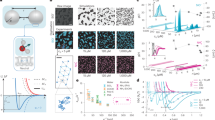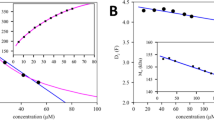Abstract
The emergent properties that arise from self-assembly and molecular recognition phenomena are a direct consequence of non-covalent interactions. Gas-phase measurements and computational methods point to the dominance of dispersion forces in molecular association, but solvent effects complicate the unambiguous quantification of these forces in solution. Here, we have used synthetic molecular balances to measure interactions between apolar alkyl chains in 31 organic, fluorous and aqueous solvent environments. The experimental interaction energies are an order of magnitude smaller than estimates of dispersion forces between alkyl chains that have been derived from vaporization enthalpies and dispersion-corrected calculations. Instead, it was found that cohesive solvent–solvent interactions are the major driving force behind apolar association in solution. The results suggest that theoretical models that implicate important roles for dispersion forces in molecular recognition events should be interpreted with caution in solvent-accessible systems.
This is a preview of subscription content, access via your institution
Access options
Subscribe to this journal
Receive 12 print issues and online access
$259.00 per year
only $21.58 per issue
Buy this article
- Purchase on Springer Link
- Instant access to full article PDF
Prices may be subject to local taxes which are calculated during checkout





Similar content being viewed by others
References
London, F. Uber einige Eigenschaften und Anwendungen der Molekularkräfte. Z. Phys. Chem. B11, 222–251 (1930).
Joh, N. H., Oberai, A., Yang, D., Whitelegge, J. P. & Bowie, J. U. Similar energetic contributions of packing in the core of membrane and water-soluble proteins. J. Am. Chem. Soc. 131, 10846–10847 (2009).
Lalatonne, Y., Richardi, J. & Pileni, M. P. Van der Waals versus dipolar forces controlling mesoscopic organizations of magnetic nanocrystals. Nature Mater. 3, 121–125 (2004).
Atwood, J. L., Barbour, L. J. & Jerga, A. Storage of methane and freon by interstitial van der Waals confinement. Science 296, 2367–2369 (2002).
Schreiner, P. R. et al. Overcoming lability of extremely long alkane carbon–carbon bonds through dispersion forces. Nature 477, 308–311 (2011).
Ruoff, R. S., Tersoff, J., Lorents, D. C., Subramoney, S. & Chan, B. Radial deformation of carbon nanotubes by van der Waals forces. Nature 364, 514–516 (1993).
Koenig, S. P., Boddeti, N. G., Dunn, M. L. & Bunch, J. S. Ultrastrong adhesion of graphene membranes. Nature Nanotechn. 6, 543–546 (2011).
Rafiee, J. et al. Wetting transparency of graphene. Nature Mater. 11, 217–222 (2012).
Rodriguez, A. W., Capasso, F. & Johnson, S. G. The Casimir effect in microstructured geometries. Nature Photon. 5, 211–221 (2011).
Hertlein, C., Helden, L., Gambassi, A., Dietrich, S. & Bechinger, C. Direct measurement of critical Casimir forces. Nature 451, 172–175 (2008).
Koski, W. S., Kaufman, J. J. & Wilson, K. M. Physicochemical aspects of the action of general anaesthetics. Nature 242, 65–66 (1973).
Autumn, K. et al. Evidence for van der Waals adhesion in gecko setae. Proc. Natl Acad. Sci. USA 99, 12252–12256 (2002).
Hunter, C. A. Quantifying intermolecular interactions: guidelines for the molecular recognition toolbox. Angew. Chem. Int. Ed. 43, 5310–5324 (2004).
Chandler, D., Weeks, J. D. & Andersen, H. C. Van der Waals picture of liquids, solids, and phase transformations. Science 220, 787–794 (1983).
Chandler, D. Interfaces and the driving force of hydrophobic assembly. Nature 437, 640–647 (2005).
Schneider, H.-J. Binding mechanisms in supramolecular complexes. Angew. Chem. Int. Ed. 48, 3924–3977 (2009).
Cabot, R. & Hunter, C. A. Molecular probes of solvation phenomena. Chem. Soc. Rev. 41, 3485–3492 (2012).
Hunter, C. A. van der Waals interactions in non-polar liquids. Chem. Sci. 4, 834–848 (2013).
Liu, T. & Schneider, H-J. Additivity and quantification of dispersive interactions—from cyclopropyl to nitro groups: measurements on porphyrin derivatives. Angew. Chem. Int. Ed. 41, 1368–1370 (2002).
Ngola, S. M. & Dougherty, D. A. Evidence for the importance of polarizability in biomimetic catalysis involving cyclophane receptors. J. Org. Chem. 61, 4355–4360 (1996).
Eftink, M. R., Andy, M. L., Bystrom, K., Perlmutter, H. D. & Kristol, D. S. Cyclodextrin inclusion complexes: studies of the variation in the size of alicyclic guests. J. Am. Chem. Soc. 111, 6765–6772 (1989).
Barratt, E. et al. Van der Waals interactions dominate ligand–protein association in a protein binding site occluded from solvent water. J. Am. Chem. Soc. 127, 11827–11834 (2005).
Malham, R. et al. Strong solute–solute dispersive interactions in a protein–ligand complex. J. Am. Chem. Soc. 127, 17061–17067 (2005).
Dessent, C. E. H. & Müller-Dethlefs, K. Hydrogen-bonding and van der Waals complexes studied by ZEKE and REMPI spectroscopy. Chem. Rev. 100, 3999–4022 (2000).
Stone, A. J. Intermolecular potentials. Science 321, 787–789 (2008).
Johnson, E. R., Mackie, I. D. & DiLabio, G. A. Dispersion interactions in density-functional theory. J. Phys. Org. Chem. 22, 1127–1135 (2009).
Chai, J.-D. & Head-Gordon, M. Long-range corrected hybrid density functionals with damped atom–atom dispersion corrections. Phys. Chem. Chem. Phys. 10, 6615–6620 (2008).
Zhao, Y. & Truhlar, D. G. The M06 suite of density functionals for main group thermochemistry, thermochemical kinetics, noncovalent interactions, excited states, and transition elements: two new functionals and systematic testing of four M06-class functionals and 12 other functionals. Theor. Chem. Acc. 120, 215–241 (2008).
Mati, I. K. & Cockroft, S. L. Molecular balances for quantifying non-covalent interactions. Chem. Soc. Rev. 39, 4195–4205 (2010).
Muchowska, K. B., Adam, C., Mati, I. K. & Cockroft, S. L. Electrostatic modulation of aromatic rings via explicit solvation of substituents. J. Am. Chem. Soc. 135, 9976–9979 (2013).
Paliwal, S., Geib, S. & Wilcox, C. S. Molecular torsion balance for weak molecular recognition forces. Effects of ‘tilted-T’ edge-to-face aromatic interactions on conformational selection and solid-state structure. J. Am. Chem. Soc. 116, 4497–4498 (1994).
Hof, F., Scofield, D. M., Schweizer, W. B. & Diederich, F. A weak attractive interaction between organic fluorine and an amide group. Angew. Chem. Int. Ed. 43, 5056–5059 (2004).
Fischer, F. R., Schweizer, W. B. & Diederich, F. Molecular torsion balances: evidence for favorable orthogonal dipolar interactions between organic fluorine and amide groups. Angew. Chem. Int. Ed. 46, 8270–8273 (2007).
Fischer, F. R., Wood, P. A., Allen, F. H. & Diederich, F. Orthogonal dipolar interactions between amide carbonyl groups. Proc. Natl Acad. Sci. USA 105, 17290–17294 (2008).
Martin, S. M., Yonezawa, J., Horner, M. J., Macosko, C. W. & Ward, M. D. Structure and rheology of hydrogen bond reinforced liquid crystals. Chem. Mater. 16, 3045–3055 (2004).
Cockroft, S. L. & Hunter, C. A. Desolvation tips the balance: solvent effects on aromatic interactions. Chem. Commun. 3806–3808 (2006).
Cockroft, S. L. & Hunter, C. A. Desolvation and substituent effects in edge-to-face aromatic interactions. Chem. Commun. 3961–3963 (2009).
Cockroft, S. L. & Hunter, C. A. Chemical double-mutant cycles: dissecting non-covalent interactions. Chem. Soc. Rev. 36, 172–188 (2007).
Bhayana, B. & Wilcox, C. S. A minimal protein folding model to measure hydrophobic and CH–π effects on interactions between nonpolar surfaces in water. Angew. Chem. Int. Ed. 46, 6833–6836 (2007).
Meyer, E. A., Castellano, R. K. & Diederich, F. Interactions with aromatic rings in chemical and biological recognition. Angew. Chem. Int. Ed. 42, 1210–1250 (2003).
Granick, S. & Bae, S. C. A Curious antipathy for water. Science 322, 1477–1478 (2008).
Tsuzuki, S. et al., Honda, K., Uchimaru, T. & Mikami, M. Estimated MP2 and CCSD(T) interaction energies of n-alkane dimers at the basis set limit: comparison of the methods of Helgaker and Feller. J. Chem. Phys. 124, 114304 (2006).
Ferrighi, L., Madsen, G. K. H. & Hammer, B. Alkane dimers interaction: a semi-local MGGA functional study. Chem. Phys. Lett. 492, 183–186 (2010).
Dack, M. R. J. The importance of solvent internal pressure and cohesion to solution phenomena. Chem. Soc. Rev. 4, 211–229 (1975).
Otto, S. The role of solvent cohesion in nonpolar solvation. Chem. Sci. 4, 2953–2959 (2013).
Marcus, Y. Internal pressure of liquids and solutions. Chem. Rev. 113, 6536–6551 (2013).
Bosque, R. & Sales, J. Polarizabilities of solvents from the chemical composition. J. Chem. Inf. Comp. Sci. 42, 1154–1163 (2002).
Smithrud, D. B. & Diederich, F. Strength of molecular complexation of apolar solutes in water and in organic solvents is predictable by linear free energy relationships: a general model for solvation effects on apolar binding. J. Am. Chem. Soc. 112, 339–343 (1990).
Mecozzi, S. & Rebek, J. Jr. The 55% solution: a formula for molecular recognition in the liquid state. Chem. Eur. J. 4, 1016–1022 (1998).
Ehrlich, S., Moellmann, J. & Grimme, S. Dispersion-corrected density functional theory for aromatic interactions in complex systems. Acc. Chem. Res. 46, 916–926 (2013).
Mal, P., Breiner, B., Rissanen, K. & Nitschke, J. R. White phosphorus is air-stable within a self-assembled tetrahedral capsule. Science 324, 1697–1699 (2009).
Chapman, K. T. & Still, W. C. A remarkable effect of solvent size on the stability of a molecular complex. J. Am. Chem. Soc. 111, 3075–3077 (1989).
Acknowledgements
The authors thank the Engineering and Physical Sciences Research Council (EP/H02056X/1) for financial support, MTEM and the School of Chemistry for a studentship to L.Y., and Pfizer for a studentship to C.A. The authors thank C.A. Hunter at the University of Sheffield for providing αs and βs hydrogen-bond parameters, and H.P.H. Saifuddin and G.H. Gowrie for the syntheses of some precursor compounds.
Author information
Authors and Affiliations
Contributions
L.Y. and C.A. performed all synthetic and experimental work. L.Y., C.A. and S.L.C. analysed the data. G.S.N. carried out X-ray crystallography. S.L.C. conceived the experiments and wrote the paper, with input from L.Y., C.A. and G.S.N.
Corresponding author
Ethics declarations
Competing interests
The authors declare no competing financial interests.
Supplementary information
Supplementary information
Supplementary information (PDF 7670 kb)
Supplementary information
Crystallographic data for compound +−1. (CIF 37 kb)
Rights and permissions
About this article
Cite this article
Yang, L., Adam, C., Nichol, G. et al. How much do van der Waals dispersion forces contribute to molecular recognition in solution?. Nature Chem 5, 1006–1010 (2013). https://doi.org/10.1038/nchem.1779
Received:
Accepted:
Published:
Issue Date:
DOI: https://doi.org/10.1038/nchem.1779
This article is cited by
-
Dimeric and trimeric catenation of giant chiral [8 + 12] imine cubes driven by weak supramolecular interactions
Nature Chemistry (2023)
-
Dynamic chiral self-recognition in aromatic dimers of styrene oxide revealed by rotational spectroscopy
Communications Chemistry (2021)
-
Competition between chiral solvents and chiral monomers in the helical bias of supramolecular polymers
Nature Chemistry (2021)
-
Stereoelectronic effects in stabilizing protein–N-glycan interactions revealed by experiment and machine learning
Nature Chemistry (2021)
-
Polarizability and isotope effects on dispersion interactions in water
Communications Chemistry (2019)



